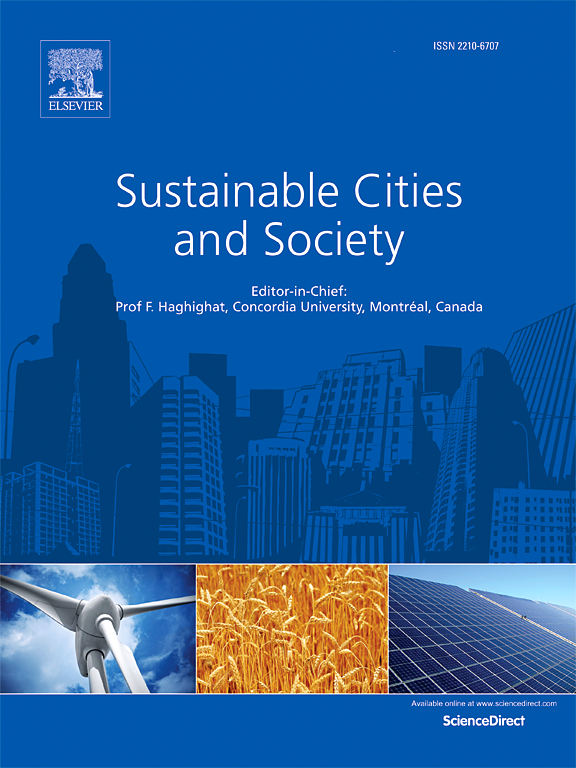Refined definition of level-of-detail for tree models in support of microclimate simulation
IF 10.5
1区 工程技术
Q1 CONSTRUCTION & BUILDING TECHNOLOGY
引用次数: 0
Abstract
Urbanisation and global climate change are amplifying urban overheating, posing challenges to livability, health outcomes, and energy consumption in built environment. Increasing trees is a primary heat mitigation strategy, with landscape design assisted by microclimate simulations. However, currently the representation of trees in microclimate models, such as the widely used ENVI-met, often falls short in supporting this task, due to insufficient level of detail (LOD). Current LOD definitions predominantly emphasize the geometric aspects of trees, often oversimplifying their physical attributes, which leads to considerable uncertainty. Consequently, previous studies on tree reconstruction focused heavily on creating models with intricate visual details but have overlooked crucial physical characteristics, thereby limiting their applicability. This study aims to fill this research gap by using ENVI-met microclimate simulations to evaluate how simulation results can be influenced by a range of tree parameters, including tree dimensions, canopy geometry, leaf area density, foliage shortwave transmittance, foliage shortwave albedo, and leaf type. Microclimate simulations are performed in two scenarios: an isolated tree and an idealized urban canyon. Both geometric characteristics and physical characteristics are found to have a significant impact on the simulation results. Therefore, a refined LOD is proposed, aiming to enhance the realistic representation of trees in microclimate simulation supporting the investigation of countermeasures to urban heat stress.
为支持小气候模拟而改进的树木模型细节层次定义
城市化和全球气候变化正在加剧城市过热,对宜居性、健康结果和建筑环境的能源消耗构成挑战。增加树木是主要的减热策略,景观设计辅以小气候模拟。然而,目前树木在微气候模型中的表示,如广泛使用的ENVI-met,由于细节水平(LOD)不足,往往无法支持这一任务。目前的LOD定义主要强调树木的几何方面,往往过度简化了它们的物理属性,这导致了相当大的不确定性。因此,以前的树木重建研究主要集中在创建具有复杂视觉细节的模型上,而忽略了关键的物理特征,从而限制了它们的适用性。本研究旨在填补这一研究空白,利用ENVI-met微气候模拟来评估一系列树木参数对模拟结果的影响,包括树木尺寸、冠层几何形状、叶面积密度、叶片短波透射率、叶片短波反照率和叶片类型。在两种情况下进行了小气候模拟:孤立的树木和理想的城市峡谷。发现几何特性和物理特性都对仿真结果有显著影响。因此,本文提出了一种改进的LOD,旨在增强树木在小气候模拟中的真实感,为研究城市热应激对策提供支持。
本文章由计算机程序翻译,如有差异,请以英文原文为准。
求助全文
约1分钟内获得全文
求助全文
来源期刊

Sustainable Cities and Society
Social Sciences-Geography, Planning and Development
CiteScore
22.00
自引率
13.70%
发文量
810
审稿时长
27 days
期刊介绍:
Sustainable Cities and Society (SCS) is an international journal that focuses on fundamental and applied research to promote environmentally sustainable and socially resilient cities. The journal welcomes cross-cutting, multi-disciplinary research in various areas, including:
1. Smart cities and resilient environments;
2. Alternative/clean energy sources, energy distribution, distributed energy generation, and energy demand reduction/management;
3. Monitoring and improving air quality in built environment and cities (e.g., healthy built environment and air quality management);
4. Energy efficient, low/zero carbon, and green buildings/communities;
5. Climate change mitigation and adaptation in urban environments;
6. Green infrastructure and BMPs;
7. Environmental Footprint accounting and management;
8. Urban agriculture and forestry;
9. ICT, smart grid and intelligent infrastructure;
10. Urban design/planning, regulations, legislation, certification, economics, and policy;
11. Social aspects, impacts and resiliency of cities;
12. Behavior monitoring, analysis and change within urban communities;
13. Health monitoring and improvement;
14. Nexus issues related to sustainable cities and societies;
15. Smart city governance;
16. Decision Support Systems for trade-off and uncertainty analysis for improved management of cities and society;
17. Big data, machine learning, and artificial intelligence applications and case studies;
18. Critical infrastructure protection, including security, privacy, forensics, and reliability issues of cyber-physical systems.
19. Water footprint reduction and urban water distribution, harvesting, treatment, reuse and management;
20. Waste reduction and recycling;
21. Wastewater collection, treatment and recycling;
22. Smart, clean and healthy transportation systems and infrastructure;
 求助内容:
求助内容: 应助结果提醒方式:
应助结果提醒方式:


